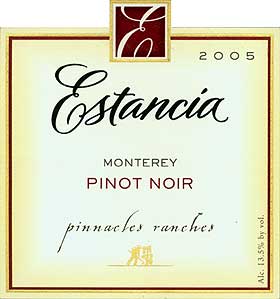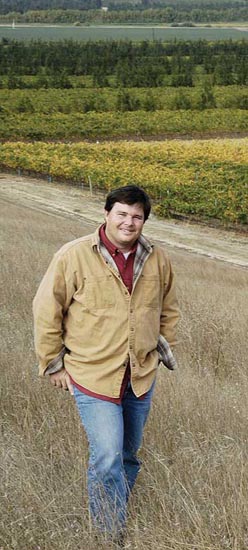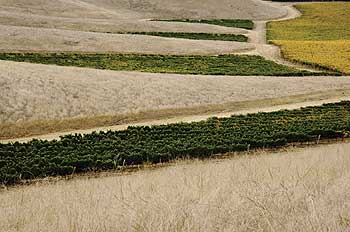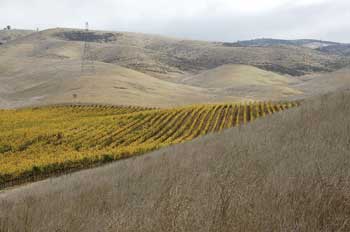

The wines produced from the grapes grown on the Pinnacles Ranch are lighter, with tendencies toward red fruit characteristics - precocious, fruity.
Estancia: The “Pinnacles” of Success
The high quality of the Pinot Noir offers Monterey a chance to provide the public with some truly unique and special wines.
~Jason Melvin, Estancia
by
Laurie Daniel
February 14, 2007
Laurie Daniel (LD): You work with two Monterey vineyards: Stonewall Vineyard in the Santa Lucia Highlands and the Pinnacles Vineyard, near Soledad, in the Monterey AVA. Do the two sites have anything in common? What are the differences?

Jason Melvin walks through fields of gold at Pinnacles Ranch.
.
Jason Melvin (JM): From a grower’s perspective, these ranches have very little in common. Both are located in northern Monterey County. Both are affected by the marine influence of the Monterey Bay. Both are affected by the Salinas Valley winds. Both are suited to cool climate varietals. That’s where the similarities end. The soils at Pinnacles are light, deep, well-drained, decomposed granite (predominantly sand with little clay or organic material) with little water or nutrient holding capacity.
In contrast, the soil at Stonewall is heavier, containing more clay and organic matter. This translates into more water and nutrient holding capacity. The fog tends to linger in the morning hours at Stonewall, while it burns off at Pinnacles. Also, the height of the Santa Lucia Mountains blocks some of the late-afternoon sun from Stonewall. The result is that on a typical day during the growing season, the Pinnacles Ranch receives more sunlight than the Stonewall Ranch. Both ranches receive relatively low amounts of rain, but Stonewall accumulates several inches more during the winter months.
These differences affect irrigation scheduling, nutrient regimes and cultural practices such as leaf removal. The root cause of these differences is location. The Stonewall Ranch is 10 miles north of the Pinnacles Ranch on the west side of the Salinas Valley at the base of the Santa Lucia Mountains. The Pinnacles Ranch is located on the east side of the Salinas Valley at the base of the Gabilan Mountain range.
LD: How do these differences affect the wines?
JM: Typically, the wines produced from the grapes grown on the Pinnacles Ranch are lighter, with tendencies toward red fruit characteristics - precocious, fruity. The wine from the Stonewall fruit is denser, more intense; the fruit is more black in nature, with an ability to be aged. Pinnacles tends to be more precocious both in the vineyard and also in wine aging. Pinnacles is warmer and leads to a wine with softer tannin earlier and bright, friendly fruit. Stonewall ripens slower both in the vineyard and in the bottle. The tannins are much firmer, and the fruit characters take longer to reveal themselves in the bottle.
LD: Stonewall is all Pinot Noir, while Pinnacles has several grape varieties. Are the Pinot Noir clones in the two vineyards similar? How have the differences between the sites influenced clonal selection?
JM: Having attended a recent Pinot Noir tasting, I feel the need to differentiate between the terms “clone” and “selection.” “Clones” are vines propagated from a genetically and/or morphologically unique mother plant. “Selections” are vines propagated from a certain location and they are not necessarily selected based on genetics or morphology. In Pinot Noir

Estancia’s Pinnacles Ranch in Monterey County AVA
discussions, the term “clone” is often used incorrectly when referring to selections.
The Pinnacles Ranch has been a testing ground for new clones and selections. As we expand and/or redevelop, we base our planting decisions on our experiences at Pinnacles. For instance, the make-up of the Stonewall Ranch was determined based on the characters of the clones or selections and the desired wine style, rather than the site itself. Pinot Noir clones/selections retain their core characteristics between sites. The site differences contribute to the wine complexity and subtleties. This is in contrast to Cabernet, where the planting site dictates the core characteristics of the fruit and the planting material dictates the subtleties.
LD: Why wasn’t any Chardonnay planted at Stonewall?
JM: The site of the Stonewall Ranch was selected and developed to provide a growing Pinot Noir program with high quality Pinot Noir fruit from an up-and-coming Pinot Noir region. Our focus was Pinot Noir. Others are very successful at growing high quality Chardonnay in the Santa Lucia Highlands.
LD: Much of the Monterey AVA has also been carved up into smaller appellations, like the Santa Lucia Highlands. Are there still some areas which should be delineated as smaller AVAs?
JM: Monterey County and the Monterey AVA are very large areas. As wine growers continue to work and plant throughout the county, more unique areas will be defined. I know there are significant differences in fruit characteristics and growing challenges within existing AVAs such as the Santa Lucia Highlands and Arroyo Seco AVAs, which could possibly lead to differentiation.
LD: What about the area where the Pinnacles Ranch is? Is there an area around that location which might warrant delineation as an AVA? Or does it make sense to leave it simply as part of the Monterey AVA?
JM: The Salinas Valley is more than 100 miles long. Within this 100 miles, you have the valley floor, the west-facing slopes on the east side, and the east-facing slopes on the west. Every 10 miles or so provides unique growing challenges depending on which of the three aspects your property is in. There is a minimum of 30 uniquely different growing regions in the Salinas Valley alone. I believe the area where the Pinnacles Ranch is located is unique enough in weather and soil composition that it could be delineated as a separate AVA. However, could we come up with something with as much cachet as Monterey? Probably not.
LD: Is there a signature wine from the Monterey AVA?
JM: Yes, there are two: Chardonnay and Pinot Noir.
LD: Would you put one ahead of the other?

Another view of Pinnacles Ranch
JM: Chardonnay is the backbone of the industry in Monterey and in the industry as a whole. The high quality of the Pinot Noir offers Monterey a chance to provide the public with some truly unique and special wines. I would give the nod to Pinot Noir.
LD: Are there some charact

Jason Melvin walks through fields of gold at Pinnacles Ranch.
Jason Melvin (JM): From a grower’s perspective, these ranches have very little in common. Both are located in northern Monterey County. Both are affected by the marine influence of the Monterey Bay. Both are affected by the Salinas Valley winds. Both are suited to cool climate varietals. That’s where the similarities end. The soils at Pinnacles are light, deep, well-drained, decomposed granite (predominantly sand with little clay or organic material) with little water or nutrient holding capacity.
In contrast, the soil at Stonewall is heavier, containing more clay and organic matter. This translates into more water and nutrient holding capacity. The fog tends to linger in the morning hours at Stonewall, while it burns off at Pinnacles. Also, the height of the Santa Lucia Mountains blocks some of the late-afternoon sun from Stonewall. The result is that on a typical day during the growing season, the Pinnacles Ranch receives more sunlight than the Stonewall Ranch. Both ranches receive relatively low amounts of rain, but Stonewall accumulates several inches more during the winter months.
These differences affect irrigation scheduling, nutrient regimes and cultural practices such as leaf removal. The root cause of these differences is location. The Stonewall Ranch is 10 miles north of the Pinnacles Ranch on the west side of the Salinas Valley at the base of the Santa Lucia Mountains. The Pinnacles Ranch is located on the east side of the Salinas Valley at the base of the Gabilan Mountain range.
LD: How do these differences affect the wines?
JM: Typically, the wines produced from the grapes grown on the Pinnacles Ranch are lighter, with tendencies toward red fruit characteristics - precocious, fruity. The wine from the Stonewall fruit is denser, more intense; the fruit is more black in nature, with an ability to be aged. Pinnacles tends to be more precocious both in the vineyard and also in wine aging. Pinnacles is warmer and leads to a wine with softer tannin earlier and bright, friendly fruit. Stonewall ripens slower both in the vineyard and in the bottle. The tannins are much firmer, and the fruit characters take longer to reveal themselves in the bottle.
LD: Stonewall is all Pinot Noir, while Pinnacles has several grape varieties. Are the Pinot Noir clones in the two vineyards similar? How have the differences between the sites influenced clonal selection?
JM: Having attended a recent Pinot Noir tasting, I feel the need to differentiate between the terms “clone” and “selection.” “Clones” are vines propagated from a genetically and/or morphologically unique mother plant. “Selections” are vines propagated from a certain location and they are not necessarily selected based on genetics or morphology. In Pinot Noir

Estancia’s Pinnacles Ranch in Monterey County AVA
The Pinnacles Ranch has been a testing ground for new clones and selections. As we expand and/or redevelop, we base our planting decisions on our experiences at Pinnacles. For instance, the make-up of the Stonewall Ranch was determined based on the characters of the clones or selections and the desired wine style, rather than the site itself. Pinot Noir clones/selections retain their core characteristics between sites. The site differences contribute to the wine complexity and subtleties. This is in contrast to Cabernet, where the planting site dictates the core characteristics of the fruit and the planting material dictates the subtleties.
LD: Why wasn’t any Chardonnay planted at Stonewall?
JM: The site of the Stonewall Ranch was selected and developed to provide a growing Pinot Noir program with high quality Pinot Noir fruit from an up-and-coming Pinot Noir region. Our focus was Pinot Noir. Others are very successful at growing high quality Chardonnay in the Santa Lucia Highlands.
LD: Much of the Monterey AVA has also been carved up into smaller appellations, like the Santa Lucia Highlands. Are there still some areas which should be delineated as smaller AVAs?
JM: Monterey County and the Monterey AVA are very large areas. As wine growers continue to work and plant throughout the county, more unique areas will be defined. I know there are significant differences in fruit characteristics and growing challenges within existing AVAs such as the Santa Lucia Highlands and Arroyo Seco AVAs, which could possibly lead to differentiation.
LD: What about the area where the Pinnacles Ranch is? Is there an area around that location which might warrant delineation as an AVA? Or does it make sense to leave it simply as part of the Monterey AVA?
JM: The Salinas Valley is more than 100 miles long. Within this 100 miles, you have the valley floor, the west-facing slopes on the east side, and the east-facing slopes on the west. Every 10 miles or so provides unique growing challenges depending on which of the three aspects your property is in. There is a minimum of 30 uniquely different growing regions in the Salinas Valley alone. I believe the area where the Pinnacles Ranch is located is unique enough in weather and soil composition that it could be delineated as a separate AVA. However, could we come up with something with as much cachet as Monterey? Probably not.
LD: Is there a signature wine from the Monterey AVA?
JM: Yes, there are two: Chardonnay and Pinot Noir.
LD: Would you put one ahead of the other?

Another view of Pinnacles Ranch
LD: Are there some charact













